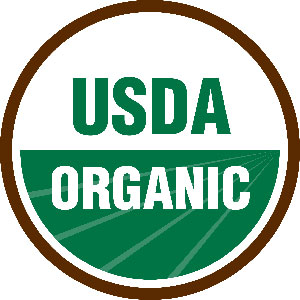Organic Standards: What Are They?

The National Organic Program was created by the U.S. Congress under the Organic Foods Production Act of 1990. The program is administered by the U.S. Department of Agriculture which is charged with inspecting the source of food and certifying that meat, poultry, eggs, and dairy products labeled “organic” come from animals who were fed no antibiotics, growth hormones, or animal byproducts. Synthetic pesticides and fertilizers, bioengineering, and ionizing radiation are also prohibited. The USDA does not verify organic products. It accredits organic certifiers to authorize the Certified Organic or USDA organic labels.
A write-up in the Animal Welfare Institute Quarterly notes that an organic label does not ensure that “organic” animals are well cared for:
Organic rules pertaining to animals have been limited to use of organically-grown feed without animal byproducts and prohibiting use of hormones and antibiotics. Granted, antibiotics should not be given to animals on a routine basis to promote growth or prevent disease. However, organic animals in need of antibiotics to treat disease are either deprived of appropriate treatment so their products can be sold as organic or are transitioned to the less lucrative conventional market which is even less concerned with animal welfare. “Organic Standards Evolving,” AWI Quarterly, Spring 2010, p. 26.
In September a report called “Scrambled Eggs” was released by the Cornucopia Institute, a Wisconsin-based farm policy research group. The report cited “widespread abuses in organic egg production,” particularly by the large industrial agribusinesses that produce 80 percent of all organic eggs. Most of these operations own “hundreds of thousands, or even millions of birds, and have diversified into ‘specialty eggs,’ which include organic,” Cornucopia explained.
The National Organic Standards Board, a citizen panel created by Congress to advise the USDA on organic policy, is currently debating proposed regulations that would establish housing-density standards for chickens and other animals raised for food under the “organic” label. The organic industry’s largest producers vehemently oppose requirements for outdoor space for chickens: “We are strongly opposed to any requirement for hens to have access to the soil,” says Kurt Kreher of Kreher’s Sunrise Farms in Clarence, New York.
Likewise, Bart Slaugh of Eggland’s Best, based in Jeffersonville, Pennsylvania, says: “The push for continually expanding outdoor access . . . needs to stop.”
Many “organic” operators provide only tiny enclosed porches, with roofs and concrete or wood flooring, yet call these structures “the outdoors,” says Cornucopia. “Many of the porches represent just 3 to 5 percent of the square footage of the main building housing the birds. That means 95 percent or more of the birds have absolutely no access whatsoever.”
Cornucopia reveals that “As in organic dairying, we discovered similar flagrant violations of the law in the organic egg business. Some of the largest operators have a note from their veterinarian, or some state official, saying ‘we recommend that you not let your birds outside to protect their health.’ And some accommodating, corporate-friendly organic certifiers have signed-off on this.”
While exposing the fraudulence of the largest producers of “organic” hens and eggs, Cornucopia praises what it calls “exemplary management practices” by many family-scale organic egg farmers. “The best producers with permanent housing profiled in Scrambled Eggs have plenty of pasture available surrounding their chickens houses, multiple popholes (doors) of adequate size and maintain the birds by rotating them into separate paddocks, allowing a rest period for the pasture to recover,” Cornucopia says.
Yet a typical family-scale egg producer praised in the report divides 2,800 hens into three movable houses, and highly rated producers with fixed hen houses are said to hold anywhere from 1,000 to 10,000 birds per house. There are also questions about where these farms are getting their birds from initially (industrial hatcheries?), the fate of the newborn male chicks, and whether hens who get sick on organic farms are receiving good veterinary care or are simply being destroyed in keeping with standard farming practices. Finally there’s the fact that once a flock is deemed by the owners to be no longer economically productive (even though the birds are young and healthy), the flock will either be killed on the farm or rounded up like garbage, thrown into transport crates, and trucked to a slaughter plant, live poultry market, or rendering company.
In their 2006 book The Way We Eat, Peter Singer and Jim Mason described their visit to Pete and Gerry’s Organic Eggs in New Hampshire where instead of finding a flock of happy hens running around in the grass and fresh air, they saw 100,000 debeaked brown hens crammed inside six long sheds with approximately 20,000 birds per shed. Each hen had just 1.2 square feet of living space for herself, and the place was “so crowded that the shed floor was visible only down the center of the shed where the hens had left a gap in between the feed and water areas on each side.” The manager told the visitors that USDA inspectors allowed the company to keep the hens indoors, supposedly to avoid possible contact with droppings from wild birds flying overhead who could conceivably be carrying an avian influenza virus; moreover, the “outdoors” from which the hens were barred was nothing but bare patches of dirt between the sheds.
The “organic” egg scam is exemplified by an operation called Black Eagle Farm in Piney Branch, Virginia, which is discussed in this issue of Poultry Press in the following pages. In October 2008, the agribusiness equipment company, Big Dutchman, announced the “official inauguration of a new layer house for organic egg production for Dr Ralph Glatt, the innovative owner of Black Eagle Farm in the US state of Virginia. . . . A total of 48,000 layers are housed in the Big Dutchman aviary. . . . The animal-friendly management system inside the house is supplemented by the attached free-range management outside the house.”
In 2009, a very different story emerged.